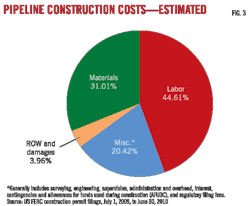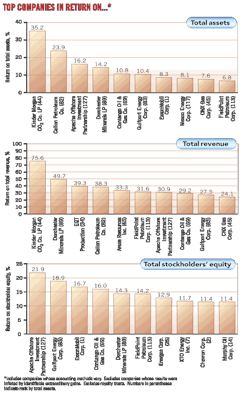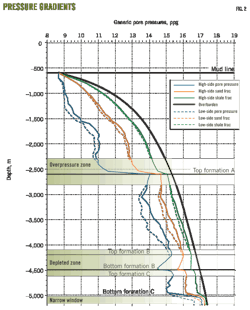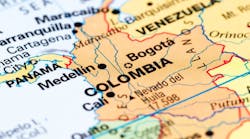A systematic approach for understanding and evaluating reservoir conditions and use of high-end technology has provided Saudi Aramco the means for developing and managing deep, high pressure, high temperature, and prolific as well as poor quality gas reservoirs.
Through the selection of appropriate stimulating methods, such as matrix acidizing, acid fracturing, or proppant fracturing, and a careful candidate selection and use of optimal procedures, Aramco has attained high production rates from gas wells. Numerous wells completed with hydraulic fracturing have sustained, stabilized, high flow rates for many years.
Optimal treatments have contributed to less drilling and the need for refracturing, thus contributing to low overall development cost. These treatment technologies have greatly enhanced field development.
Fracturing design
Saudi Arabia needs increased gas production to meet domestic demand. Hydraulic fracturing is one key practice Saudi Aramco has initiated and carried out for improved gas rate, production sustainability, and ultimate recovery.
Depending on formation characteristics, the company has designed wells to maximize reservoir contact, improve production, and preserve wellbore integrity. The design requires careful selection of well type, drilling azimuth, and completions for executing the subsequent hydraulic fracturing.
Due to the complex and varying formations, each well type requires a specific fracture treatment design and implementation for obtaining optimal results. The process includes appropriate candidate selection, testing of acid and other fracture fluid properties, durability and long-term conductivity tests of proppants, and thorough modeling and sensitivity studies.
The results of the process ensure an optimal injection rate, volume, expected fracture length, and fracture conductivity.
Fracture treatments in Ghawar field have evolved from simple and direct methods used in vertical wells to the use of multistage fracturing in horizontals.1-4
The optimized fracture design depends on reservoir characteristics such as permeability, porosity, reservoir thickness, average pressure, and sanding tendency. A good treatment includes correct selection of fracture fluid type, injection volume, injection rate, proppant properties, and treatment size.
Saudi Aramco designs treatments using a full 3D hydraulic fracturing model and monitors the treatments during actual execution. To assess the increased production from the treatment, the company routinely performs post-fracture diagnostics and evaluations with pressure buildup analysis, production history match, and long-term observation of stabilized rates.
Reservoir conditions play a major role in planning drilling and fracturing strategy.
For moderate to high permeability sandstone reservoirs with restricted high-rate production because of the possibility of producing sand, the design used includes running casing across the reservoir section and perforating the relatively tighter intervals oriented in the direction of the maximum horizontal in situ stress.
Oriented perforations reduce near wellbore friction pressure loss, align the fracture with the perforations, and improve fracture wellbore connectivity.
The fracturing treatment has a moderate size, usually contains 16-30 mesh intermediate strength proppants, and preferably is followed by resin-coated proppants to prevent sand flow back.
The treatments often include conductivity enhancing chemicals in high-permeability wells.
In reservoirs where unconsolidated sand occurs throughout the pay, the procedure is to run casing in the wellbore, cement, and perforate over the entire reservoir interval before the installation of sand screens and frac or gravel packs that contain a small proppant amount to bypass the damaged zone.
This method has been successful, but it also carries the risk of reduced productivity in the long run due to gradual proppant-pack deterioration from fines migration and reservoir pressure decline. It also might be difficult to preserve screen integrity during deployment of the completion system and fracturing operation.
Once a screen is damaged, sand inflow becomes unrestricted and salvaging the well would require sidetracking. In such highly sanding reservoirs, Saudi Aramco now drills long horizontals and completes them with an expandable sand screen that keeps the formation from collapsing, provides greater flow area, and eliminates proppant-related skin in the annulus.
Tight formations with horizontal wells drilled to attain high reservoir contact always require fracturing for obtaining better connectivity with the virgin reservoir, bypassing damage, and improving flow rate.
Saudi Aramco has introduced multistage fracturing in such reservoirs and has pumped many treatments that show the viability of this method. MSF is applicable in both carbonate and sandstone reservoirs.
Geomechanics
Reservoir mechanical properties supply valuable data for designing and assessing drilling and hydraulic fracturing processes. Extensive testing of reservoir cores provides rock mechanical characteristics, such as Young's modulus, Poisson's ratio, and unconfined compressive strength.
Based on testing cores in the laboratory and calibration of the geomechanical properties with field-measured data, Saudi Aramco has developed a comprehensive in situ stress and sand prediction model to determine rock strength, safe drawdown pressure, and onset of sand production for any given formation and field.
Due to the nonlinear nature of sanding, various field measurements to quantify the amount of sand produced as a function of gas rate and flowing pressures are important for calibrating the coefficients incorporated in the model.
Reservoir stimulation
Reservoir stimulation has become routine in Saudi Aramco's gas wells. The treatments in sandstone reservoirs (Jauf and Unayzah) involve hydraulical fracturing with 40-45 lb/1,000 gal of crosslinked gel associated with 20/40 or 16/30 mesh intermediate-strength proppants.
Formation quality determines the amount of proppant, and Saudi Aramco has used between 50,000-500,000 lb in treatments conducted to date.
The use of 28% hydrochloric acid is common for carbonate reservoirs (Khuff). The jobs include either fracturing or matrix acidizing, depending on rock quality and gas potential.
A conventional acid schedule consists of multiple stages of crosslinked polymer-based pad to fracture the formation and keep the fracture open, diesel emulsified acid to obtain deep penetration, and gelled acid to enhance near wellbore conductivity.
The amount of acid and injection rate depends on the reservoir conditions, such as porosity and permeability, and also on the type of treatment selected.
Saudi Aramco stimulates all types of reservoirs with a varying range of heterogeneity, multiple layering, and different lithology. The success of any treatment depends on understanding the reservoir characteristics and design and implementation of an optimal program.
Consolidated reservoirs
For somewhat tighter and consolidated Ghawar sandstone reservoirs, Young's modulus ranges from 5 to 10 × 106 psi with unconfined strength of 15,000 psi or more, indicating a consolidated, high-strength formation.
These wells have perforations over the entire net pay of the reservoir, and the completion involves hydraulic fracturing.
The stimulation treatment in Well SA-1, completed in the Unayzah with a 60-ft perforated interval, included 250,000 lb of intermediate strength proppants (Fig. 1). History matching real-time data indicate that the fracture covered the entire 120-ft pay interval with an effective half-length of more than 100 ft.
The production log run after the cleanup of the well showed a uniform rate contribution from the productive intervals of 20 MMscfd total at a 1,500-psi flowing wellhead pressure.
Two indications of a successful treatment are that the well produced no sand or proppant during flow and achieved a high rate.
Partially consolidated sand
Saudi Aramco carefully studies the nature and intensity of sanding to select drilling, completion, and fracturing strategies.
To develop partially consolidated reservoirs, Saudi Aramco has used indirect fracturing. This requires the drilling of vertical wells completed with a cemented liner and selectively perforated in the tighter reservoir sections as indicated from openhole logs and core analysis. The perforations are towards the direction of the maximum stress (oriented perforation), and the proppant fracture treatment connects the perforated section with the rest of the potential intervals.
Fig. 2 illustrates an example (Well SA-2) of indirect fracturing. The three column log shows lithology, sanding model, and geomechanical properties. The sanding model predicts a catastrophic failure, transition, and no sand region in the gas interval.
The analysis indicates the well, perforated in the transition zone, could expect some sanding; so that the frac job used sand-control chemicals with the proppant to eliminate any sand production.
Optimization of the fracture treatment plan involved selecting the correct perforation interval, appropriate mesh size, proppant type, sand, and proppant flow-back control materials, as well as determining an injection schedule.
The propped fracture geometry (Fig. 2) indicates full coverage over the entire 100-ft gas interval, even though the well had only a 40-45 ft perforated section. The well after fracturing flowed at 50 MMscfd with a 3,500-psi flowing wellhead pressure, indicating a successful stimulation treatment with all net pay stimulated.
Unconsolidated sand
In reservoirs where the entire net-pay section is unconsolidated sand, one cannot use indirect fracturing techniques and needs to use frac-pack stimulation and completion methods. Such completions usually involve perforating the entire sand thickness and completing the wells with sand screens placed inside production liners.
Subsequent to this operation, the completion process includes fracturing the wells and placing the proppant not just in the formation but also in the annulus area between the sand screen and liner. Saudi Aramco has completed numerous wells with frac packs.
This completion process generally introduces high turbulence and near-well skin and may have a risk associated with screen deployment and plugging the screen while pumping the fracture treatment.
Fig. 2 shows an example of Well SA-3 in which the cores show a very high-porosity interval (25% or more) perforated and completed with a frac-pack treatment.
The well tested at 40 MMscfd sand free with a 4,000 psi flowing wellhead pressure.
Multistage fracturing
The reason for drilling horizontal wells is to attain large reservoir contact. But the increased drilling time of these wells exposes the formations to drill-in fluids and additives for much longer, potentially damaging the near wellbore region.
For tight formations, the damage is severe due to water-blockage effects and possible loss of effective communication between the wellbore and formation.5 Hydraulic fracturing is the only means to restore the lost communication and stimulating the well.
Saudi Aramco deploys the MSF technique with the drilling rig during the completion phase. The MSF system consists of frac ports, openhole packers, anchor packers, ball-seats for isolation, and blank pipes.
The procedure involves placing the MSF injection ports against the intervals where fractures should initiate. Openhole packers isolate individual intervals between two adjacent ports.
Engineers determine the number of packers and ports needed after a full review of the openhole log and rate enhancement analysis. The anchor packer at the bottom provides system balance and support.
Well SA-4 targeted the K-C carbonate with a 2,000 ft of reservoir contact (Fig. 3). The selected design was a trajectory based on reservoir development in offset wells and the seismic impedance profile in that area. The reservoir section drilled has an 83⁄8-in. hole, and openhole logs evaluated formation properties.
Based on reservoir potential and porosity development, the treatment design included three stages and deployment of an MSF completion with the required number of frac ports and packers.
The design based each acid treatment stage on net exposed length and reservoir quality. The main acid for the fracture treatment consisted of high-temperature 28% emulsified HCl acid and in situ gelled HCl acid.
The planned job had four pad stages between the acid stages along with optimal acid volumes to maintain net pressure, ensure good acid penetration, and create a highly conductive fracture.
Fig. 4 shows the effectiveness of Stage 3 of the acid treatment. The pressure builds during the pumping of the pad and drops as acid penetrates and reacts with the formation.
After the successful execution of all three stages, the well was flowed back for cleanup and rate assessment. The well initially flowed 50 MMscfd with 1,950 psi of flowing wellhead pressure. The bs&w was high, about 20% during this measurement.
This initial result outperformed the flow-back results of the offset wells in the area.
The well when put on production to the gas plant flowed at a long-term, stabilized restrained rate of 25 MMscfd. Pressure transient tests (Fig. 4) showed a clear indication of fracture behavior from the half-slope pressure derivative line, and the overall calculated average fracture half-length was in excess of 100 ft.
Perforation techniques
Saudi Aramco now has started to implement in selective wells a new method to establish better communication of the reservoir with the wellbore The method creates perforations by jetting abrasive fluids through a cased-hole completion.
Unlike conventional perforations, jetting eliminates any perforation related damage, such as debris and crushed formation. The placement of perforations is based on openhole logs.
The perforation diameters are about 1-in. and penetration into the formation can range from 5 to 10-in. and sometimes more depending on the rock toughness.
A 2-in. coiled-tubing unit runs the perforation tool. The abrasive element is either 100 mesh or 20/40 mesh sand carried in 40 lb/1,000 gal of linear gel at a 0.5 ppg concentration. The jetting, conducted through coiled tubing at a high rate, creates a hole in the cased completion and in the formation.
After creation of the perforations in selected intervals, the next step treats the well with the pad and acid sequence at a high rate to create small conductive hydraulic fractures. Fig. 5 shows the openhole logs of Well SA-5 and the selected perforation intervals.
Well SA-5 is a 77° deviated well with 270 ft of net pay, which is equivalent to a net vertical interval of 70 ft.
The design work selected 12 jetting spots, each with three holes, within the five best net intervals (Fig. 5). Subsequently, the well treatment included 10,000 gal of 15% HCl.
The poststimulation rate was excellent, about 30 MMscfd with a 2,400-psi flowing wellhead pressure, confirming the success of the jetting perforation technique and acid treatment.
Fig. 5 shows the wellhead inflow performance.
Fiber diversion
The heterogeneous nature of the Khuff carbonate reservoir requires a uniform treatment of the entire interval with acid for an effective stimulation. Perforating all intervals and pumping a conventional pad and acid sequence will not achieve an effective stimulation.
The hybrid nature of the reservoir will initiate the fracture in the interval with the lowest resistance (typically a high-porosity zone). Once the acid reaches this zone, the pressure will drop as acid reacts, preventing other intervals from being fractured. Acid spending during the treatment process will accelerated greatly due to high formation temperature, leading to over-stimulation of the most prolific intervals.
To overcome this problem, one should ideally treat potential gas zones separately, which becomes costly, difficult, and often unrealistic. The other alternative is to use some materials or chemicals to divert fluids and evenly distribute acid to all intervals of interest.
The fiber diversion system, when correctly designed and staged, directs acid to a new interval after the treatment of the previous interval.6 7
The diversion chemical forms a gel against the intervals where acid has spent (lower pH concentration) and creates a barrier. The gel allows rebuilding of net pressure and subsequently the fracturing and acid stimulating of new intervals.
Repeating the process requires careful planning and scheduling of the treatment, selecting an optimal volume of fluid and fiber, and using the correct pump sequence. After completion of the treatment, the fiber and gel dissolve with time and temperature and flow back during cleanup operation.
Exemplary results verify the benefits of the fiber diversion system. The system has achieved not only high total production rates but also, based on production logs, high individual contributions from each interval.
The design of these jobs involves selecting perforation intervals based on reservoir development indicated by openhole logs. Three example wells (Fig. 6) show different intervals perforated before conducting acid treatments.
Wells SA-6 and SA-7 treatments were with the fiber diversion acid system while the Well SA-8 treatment was with a conventional acid. Subsequent production logging runs indicate uniform gas flow from all intervals in the first two wells.
In the case of well SA-8, the top and bottom-most perforations did not contribute much. The higher porosity, middle intervals, clearly dominated in taking in the stimulation fluid. This example therefore confirms the advantage of the fiber diversion system over conventional acidizing.
Fig 7 shows the difference in production and ultimate recovery between a well uniformly treated in all intervals vs. another well treated in 50% of its productive interval. A 10-year production forecast shows 20% improved production and recovery in wells where all intervals are treated uniformly.
The rate decline indicates the need for optimizing the stimulation program and using the fiber diversion system when applicable. One needs to carefully study and understand the flow capacity contrast and reservoir characteristics before selecting the correct acid system.
Acknowledgments
The authors thank Saudi Aramco management for permission to publish this article. Special thanks to the technical teams in the gas reservoir management and gas production engineering divisions of Saudi Aramco for their assistance in providing and evaluating data, assessing well performance, and implementation of new technology in the field.
References
1. Al-Qahtani, M.Y., and Rahim, Z., "Optimization of Acid Fracturing Program in the Khuff Gas Condensate Reservoir of South Ghawar Field Saudi Arabia by Managing Uncertainties Using State-of-the-Art Technology," Paper No. SPE 71688, SPE ATCE, New Orleans, Sept. 30-Oct. 3, 2001.
2. Rahim, Z., and Petrick, M., "Sustained Gas Production From Acid Fracture Treatments in the Khuff Carbonates, Saudi Arabia: Will Proppant Fracturing Make Rates Better? Field Example and Analysis," Paper No. SPE 90902, SPE ATCE, Houston, Sept. 26-29, 2004.
3. Saudi Aramco Gas Reservoir Management Division internal documentation.
4. Solares, R., et al., "Successful Multistage Horizontal Well Fracturing in the Deep Gas Reservoirs of Saudi Arabia: Field Testing of a Promising, Innovative, New Completion Technology," Paper No. SPE 114766, SPE ATCE, Denver, Sept. 21-24, 2008.
5. Al-Jubran, H.H., Wilson, S., and Johnston, B., "Successful Deployment of Multistage Fracturing System in Multilayered Tight Gas Carbonate Formations in Saudi Arabia," Paper No. SPE 130894, Deep Gas Conference and Exhibition, Manama, Bahrain, Jan. 24-26, 2010.
6. Al-Anazi, H.A., et al., "The Impact of Completion Fluids on Productivity in Gas/Condensate Reservoirs," Paper No. SPE 94256, SPE Production and Operations Symposium, Oklahoma City, Apr. 17-19, 2005.
7. Solares, R., et al., "Field Trial of a New Non-Damaging Degradable Fiber-Diverting Agent Achieved Full Zonal Coverage during Acid Fracturing in a Deep Gas Producer in Saudi Arabia," Paper No. SPE 115525, SPE ATCE, Denver, Sept. 21-24, 2008.
The authors
More Oil & Gas Journal Current Issue Articles
More Oil & Gas Journal Archives Issue Articles
View Oil and Gas Articles on PennEnergy.com












